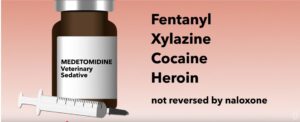
In October of 2012, British researchers found carfentanil in the clothing of two British survivors of the 2002 Moscow theatre hostage crisis, when the Russian military used an aerosol form of carfentanil to subdue Chechen hostage takers. Because of the lack of information provided to emergency workers, they didn’t bring enough naloxone or naltrexone to prevent the complications experienced by the gassed victims. “One hundred and twenty-five people exposed to the aerosol are confirmed to have died from respiratory failure during the incident.” But carfentanil wouldn’t register as a drug of concern on the U.S. opioid radar for another 14 years.
At the beginning of July in 2016, a series of overdoses and deaths occurred in Ohio around Akron. Some of the first overdoses were from people who were snorting what they thought was heroin. The overdoses were attributed to a street mixture of heroin and carfentanil. Then more overdoses were reported in Columbus and Cincinnati. There were 78 overdoses and at least 3 deaths during a 48-hour time period in Cincinnati.
Over 300 cases of overdose from fentanyl and carfentanil were reported in the Summer and Fall of 2016. They occurred in Ohio, West Virginia, Indiana, Kentucky and Florida. In June of 2016 the Royal Canadian Mounted Police seized one kilogram of carfentanil shipped from China in a box labeled “printer accessories.” It was not a controlled substance in China until March of 2017. Until then it was manufactured and legally sold openly over the Internet, actively marketed by several Chinese chemical companies.
A 2020 study for the journal Addiction, “Carfentanil and the Rise and Fall of Overdose Deaths in the United States,” investigated the 2018 decline in overdose deaths in the U.S. The researchers found in addition to public health interventions, the decline coincided with the regulation and decreased use of fentanyl analogues, especially carfentanil. They looked at a total of 1,035,923 drug overdose deaths in the U.S. from 1979 through 2019. The years 2016 (+21.4%) and 2017 (+10.4%) saw a rapid increase in overdose deaths. This was followed by a decline in 2018 (-4.1%). “This rise and then fall coincided with a surge and then decline in carfentanil drug seizure exhibits during these same years: 0 (2015), 1292 (2016), 5,857 (2017) and 804 (2018).”
 Carfentanil is used as a tranquilizer for elephants and other large mammals. It is 100 times more potent than fentanyl; and 10,000 times more potent than morphine. Just .02 mg can be lethal for humans. “A carfentanil-related overdose can require more than three shots of naloxone to reverse.” Both the CDC and Medscape said after outbreaks of carfentanil-involved overdose deaths in 2016-2017, it largely disappeared from the drug supply. For more information, see “The Devil in Ohio” and “Here’s Some Gray Death.”
Carfentanil is used as a tranquilizer for elephants and other large mammals. It is 100 times more potent than fentanyl; and 10,000 times more potent than morphine. Just .02 mg can be lethal for humans. “A carfentanil-related overdose can require more than three shots of naloxone to reverse.” Both the CDC and Medscape said after outbreaks of carfentanil-involved overdose deaths in 2016-2017, it largely disappeared from the drug supply. For more information, see “The Devil in Ohio” and “Here’s Some Gray Death.”
Carfentanil’s Comeback
The CDC released an update in August of 2024 that suggested there had been an overall decrease of overdose deaths in the U.S. since 2018 of 12.2%. This was a relatively small drop, only the second annual decline in more than 30 years. Experts were mostly reserved with their assessment, with one describing it as a leveling off. Nevertheless, opioid overdose deaths dropped to the lowest level in three years. But then in December of 2024, the CDC released another report that indicated carfentanil was making a comeback.
Medscape said there were 29 overdose deaths from carfentanil between January and June of 2023, but that rose to 238 for the same time period in 2024—an increase of 700%. Since illegally manufactured fentanyls (IMFs) like carfentanil were first detected in 2013, they have replaced heroin as the most common opioid in the U.S. In the Northeast, Midwest, and South regions the percentage of overdose deaths was high (70%-80%) but stable from 2021 to June 2024, but not in the West. Researchers speculated the increase of IMF-related overdose deaths in the West could be due to fentanyl entering the drug markets of that region later than the other areas. “Likely because of challenges of mixing fentanyl into the black tar heroin that was more common in the West.”
The CDC said the stability suggested that IMFs have become the dominant illegal opioid. This saturation might lead to a lower overdose risk, as drug users have increased their tolerance and become more aware that IMFs were now in the drug supply. Mixing non-opioid drugs such as xylazine into the fentanyl supply might also have been a factor in the reduction of overdose risk. However, “Despite declines, recent sharp increases in overdose deaths with carfentanil detected, although rare, highlight the ever-changing illegal drug supply and threaten progress in reducing overdose deaths.”
In this context of suggested saturation of the drug supply with IMFs and the potential for reduced overdose risk, more persons might be able to avoid or survive overdose and subsequently benefit from overdose prevention programs that have been implemented; this could be partially responsible for the decline in overdose deaths starting in late 2023. Continued and expanded implementation of these programs, including naloxone distribution and increasing access to treatments for substance use disorders, might result in sustained and continued declines in drug overdose deaths. However, the potential for increases in overdoses remains if drugs more potent than fentanyl, including carfentanil, continue to adulterate the supply.
The CDC was concerned that while overdose deaths with carfentanil are still rare, because of its extreme potency, overdose deaths “could substantially increase if carfentanil further infiltrates the drug supply, as evidenced by previous outbreaks.” The current geographic spread covering 37 states and substantial detection in IMFs (87%) are markedly different than what was seen in 2016-2017, where the outbreaks were geographically localized and found in less than 25% of IMFs.
The potential mixing of carfentanil into fentanyl products as an adulterant raises concern that its presence might be unknown to persons using drugs, reminiscent of the way that fentanyl was first introduced as an adulterant of heroin. Rigorous monitoring of carfentanil and other opioids more potent than fentanyl, such as some nitazene analogs that are currently rare but persistent in overdose deaths, is warranted because of increased fatal overdose risk that could threaten recent progress in reducing overdose deaths.
Implementing prevention efforts focused on the risk of IMFs, including carfentanil, is critical to sustain the reduction in overdose deaths. These efforts should include education about the dangers of using pills that are not prescribed, because they could be counterfeit and contain IMFs. Drug checking services are another recommendation, as well as increased access to naloxone to reverse overdoses. Fentanyl test strips may help identify products containing fentanyl, but they can’t distinguish between carfentanil and fentanyl.
Since carfentanil is a fentanyl analog, prevention efforts focused on IMFs should also be effective for reducing overdoses involving carfentanil. “However, given carfentanil’s high potency, more doses of naloxone and faster overdose response might be required to prevent death.” Combining the risk reduction efforts with efforts to reduce drug use described by the CDC could lead to “lasting decreases in overdose deaths that could withstand changes in the drug supply.”
The Seduction, Profitability, and Danger of Carfentanil
The Conversation reported that carfentanil was first synthesized in 1974 at Janssen Pharmaceuticals. A 10 mg dose is enough to knock out or even kill a fully grown African elephant. It’s too powerful to use as a painkiller in human medicine. With its history of being used as a chemical weapon and as an elephant tranquilizer—too powerful for human use—how could it be making a comeback in the illegal drug supply of the U.S.?
Of the many analogues of fentanyl, carfentanil is the most potent yet synthesized. It binds most strongly to the mu-opioid receptor, resulting in pain relief and the euphoric effects sought by recreational drug users. Street dealers cut heroin with it to give their IMF a harder-hitting, longer-lasting high. “Due to the potency of the drug, there is also a risk to paramedics, healthcare workers and laboratory personnel.”
Also, due to the chemical nature of the drug it can be stored in fatty tissue and subsequently, two to 24 hours later, redistributed in the blood stream resulting in a phenomenon known as “re-narcotisation” where the effects of the drug are observed again in an overdose patient after they have been stabilised.
The clinical director of addiction services at the University of Cincinnati told Fox News that carfentanil’s high profitability drives its prevalence: “Very small amounts can produce thousands of doses.” Unlike heroin, it is relatively easy to manufacture in illicit labs. Inhaling the drug can be quite risky, because it enters the bloodstream and results in an overdose. “This can happen intentionally or accidentally, as the drug can become easily airborne,” leading to its danger to paramedics and others.
Waves of Overdose Deaths
Opioid overdose deaths have been characterized as coming in waves, as the CDC illustrated in “Understanding the Opioid Overdose Epidemic.” The first wave began with increased prescribing of opioids in the 1990s. The second wave began in 2010 with rapid increases in overdose deaths with heroin. The third wave began in 2013, with significant increases in overdose deaths with synthetic opioids, particularly illegally made fentanyl and fentanyl analogues (IMFs), like carfentanil.
Researchers are now describing a fourth wave of overdose deaths consisting of illicit stimulants mixed with fentanyl. NPR said many users don’t know they are at risk of ingesting opioids, so they don’t take overdose precautions. In the Northeast the stimulant tends to be cocaine; and methamphetamine in the West, Midwest and South. A study published in September of 2023 by Joseph Friedman and Chelsea Shover in the journal Addiction said the rise of deaths involving cocaine and methamphetamine should be understood in the context of a drug market dominated by illicit fentanyls. “Which have made polysubstance use more sought-after and commonplace.” See the following figure from the study.
The rise of deaths involving cocaine and methamphetamine must be understood in the context of a shifting illicit opioid drug market increasingly dominated by illicit fentanyls. Recent ethnographic and qualitative research suggests that fentanyls have created conditions that make polysubstance use more sought-after and commonplace. For instance, many individuals report that mixing a small amount of methamphetamine into injected doses of fentanyl subjectively prolongs the onset of withdrawal symptoms, increases euphoria, decreases overdose risk and improves energy levels required to continue to collect funds for the next set of drug purchases.
Given the short duration of fentanyls, these perceived advantages to drug users require more frequent injections than heroin, heightening the risk of overdose. Similar findings have been reported with studies of xylazine and other drugs commonly added to fentanyls. There is an increased risk of negative health outcomes, including overdosed individuals who are not fully responsive to naloxone. And they often require additional life-saving measures such as airway management.
We’ve come a long way since morphine was first isolated from opium in 1804 and Alexander Wood invented the syringe in 1853. His wife was falsely reported as the first morphine addict and first person to die of an injected drug overdose. Here’s hoping we find a way to manage carfentanil and the rise of IMFs before the fifth wave of overdose deaths hits us.






